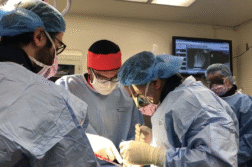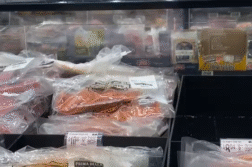SAN ANTONIO, Texas (Ivanhoe Newswire) – We swallow 600 times a day and never notice until we struggle with choking. The condition is called dysphagia. Early rehabilitation is critical to avoid food accidentally getting into the lungs, pneumonia, malnutrition, and severe illnesses. Swallowing
We swallow once a minute while awake and three times an hour while asleep.
“Your esophagus is tonically closed, so, it only opens when you swallow,” says Professor at UT Health Science Center in San Antonio, Texas, Giselle Carnaby, PhD.
But for 15 million Americans with dysphagia, throat muscles weaken, the hole doesn’t close and they choke on saliva or food.
“And as the muscular weakness in the upper end of the swallow starts, they start to squeeze less, push less, move less, and it becomes cyclical and you get what’s called a diffuse atrophy,” Carnaby says.
Susan Craig has Parkinson’s and manages muscle strength with boxing and stays active by traveling. But just like body muscles, weak oral muscles lead to real problems.
Carnaby explains, “We know that a good 40% of the general elderly population will experience some of these difficulties.”
So, Susan is in Carnaby’s rehab — swallowing more frequently, and mastering meds by putting pills in applesauce for easier consumption.
“She’s teaching you how to swallow. It has nothing to do with, like, your bite size and chewing, and all that is fine,” Susan says.
If you experience pain or difficulty swallowing, Professor Carnaby advises you to consult a swallowing specialist, swallow more frequently to build strength, manage underlying conditions like acid reflux and COPD. Otherwise …
“You become less mobile, you become more fragile, you’re then more susceptible to diseases because you don’t have a healthy immune system.”
Other treatment techniques include neurostimulation, especially for stroke patients with dysphagia, who wage a daily struggle with eating.
Contributors to this news report include: Donna Parker, Producer; Kirk Manson, Videographer; Roque Correa, Editor.
To receive a free weekly e-mail on medical breakthroughs from Ivanhoe, sign up at: http://www.ivanhoe.com/ftk
Sources:
National Institute of Health
MEDICAL BREAKTHROUGHS
RESEARCH SUMMARY
TITLE: RELEARNING THE ART OF SWALLOWING
REPORT: MB #5396
BACKGROUND: Dysphagia is a medical condition characterized by difficulty swallowing. It can affect any part of the swallowing process, including the mouth, throat, or esophagus. This condition can range from mild to severe and can lead to complications such as malnutrition, dehydration, and aspiration pneumonia if left untreated. The prevalence of dysphagia in the general adult population is estimated to be around three percent to five percent. However, the condition is more common in certain groups, such as older adults and those with specific medical conditions. Dysphagia is a common complication of stroke, affecting up to 65 percent of stroke patients. Swallowing difficulties can occur due to damage to the brain areas responsible for coordinating swallowing. Patients with dysphagia often require more medical care, including hospital stays and specialized treatments such as swallowing therapy which can result in higher healthcare costs.
(Sources: https://www.mayoclinic.org/diseases-conditions/dysphagia/symptoms-causes/syc-20372028
https://www.sciencedirect.com/science/article/pii/S1542356519311826
DIAGNOSING: Diagnosing dysphagia involves assessing a patient’s medical history, conducting a physical examination, and performing various diagnostic tests to identify the underlying cause of swallowing difficulties. A doctor will begin diagnosis by asking the patient about their symptoms, such as difficulty swallowing, coughing, choking, or food getting stuck. They next determine when symptoms began and how they will progress. Reviewing a medical history and medication history is important as some may affect swallowing. Physical examinations assess the function of cranial nerves involved in swallowing and observe the patient’s ability to swallow different types of foods and liquids. Several different diagnostic tests may be used to evaluate the swallowing process and identify the cause of dysphoria.
(Sources: https://www.mayoclinic.org/diseases-conditions/dysphagia/diagnosis-treatment/drc-20372033
NEW TECHNOLOGY: A new MRI sequence novel wearable surface electromyography sensor technology developed by the author’s team has been presented as an example of recent technological advances that could play an important role in the future of personalized dysphagia care. There is a large need for the development of sensitive new tools that will allow personalized examinations of swallowing mechanisms. These experts believe the digital age is the perfect time to begin leveraging techniques like imaging, wearables, and machine learning.
FOR MORE INFORMATION ON THIS REPORT, PLEASE CONTACT:
Kate Hunger
If this story or any other Ivanhoe story has impacted your life or prompted you or someone you know to seek or change treatments, please let us know by contacting Marjorie Bekaert Thomas at mthomas@ivanhoe.com




